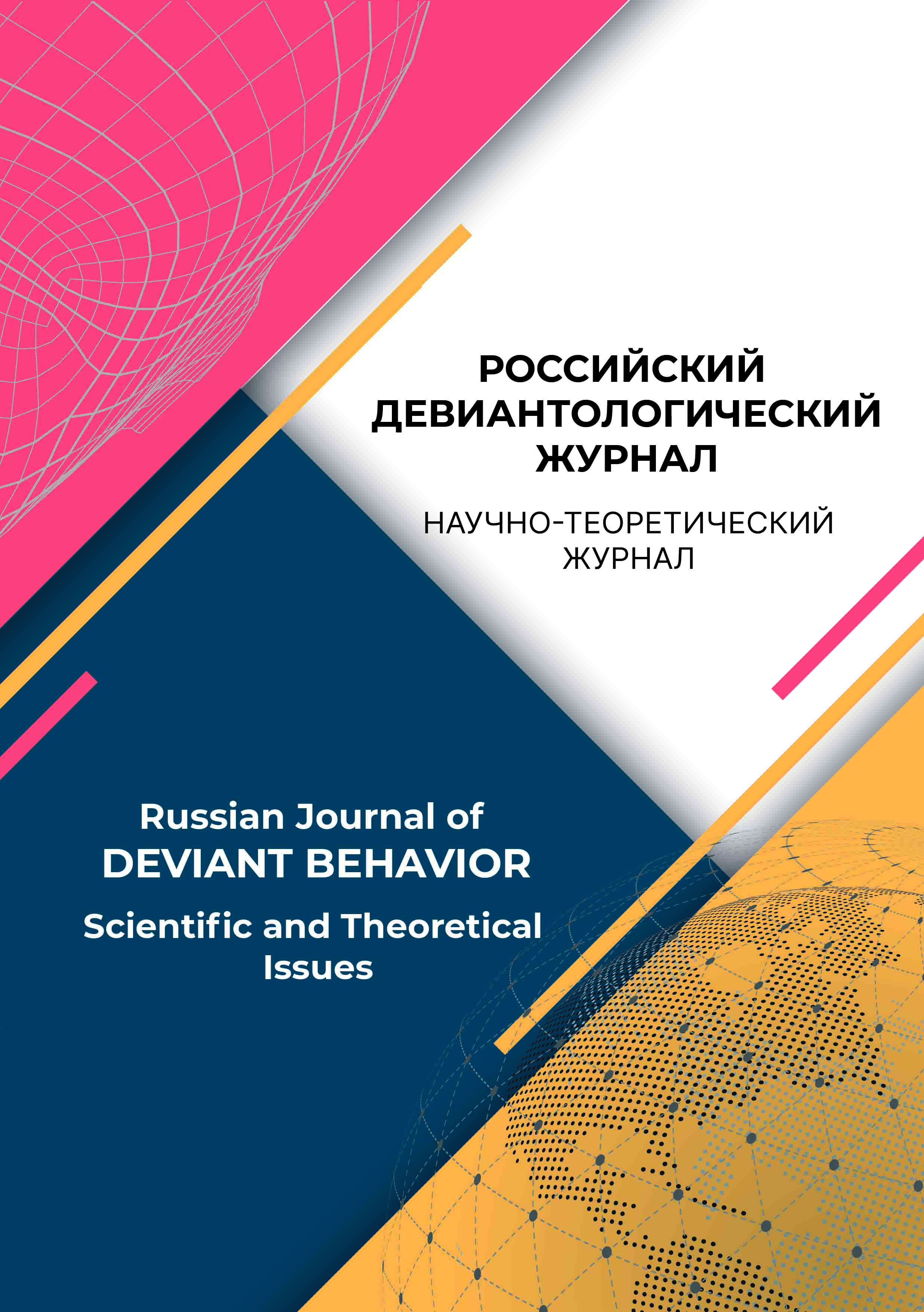сотрудник
Санкт-Петербург, г. Санкт-Петербург и Ленинградская область, Россия
с 01.01.2020 по настоящее время
УДК 343 Уголовное право. Уголовное судопроизводство. Криминология. Криминалистика
Прямые интернет-трансляции — это возможность участвовать в цифровой социальной жизни общества как для стримеров, так и для их аудитории. Такое участие связано в том числе с возможностью распространения контента, считающегося социально и общественно вредным. Несмотря на то что так называемые в зарубежной юридической литературе «мусорные потоки» популярны в Центральной Европе уже несколько лет, им до сих пор не было уделено должного внимания представителями криминалистической науки. Данное исследование в какой-то мере позволит восполнить этот пробел. Основываясь на длительном наблюдении за активностью «мусорных потоков» и обзоре доступной по данной проблематике юридической литературы, а также сообщений средств массовой информации, авторы дают всестороннее описание «мусорных потоков», указывая на различия в номенклатуре терминов и понятий, используемых, в частности, в Польше и некоторых других зарубежных государствах. В статье приведены некоторые методические указания по изучению «мусорных потоков». Авторы разработали данные рекомендации на основе анализа литературы и собственного исследовательского опыта.
социальная патология, онлайн-коммуникация, прямой эфир, язык ненависти, пользовательский контент, трэш-контент
1. Angielczyk, P. Z. (2019). Homo Crudelis in the Era of Internet. Parezja, 2 (12), 48-64.
2. Artwick, C. G. (2019). Social media livestreaming: Design for disruption? Abingdon: Routledge.
3. Bek, D., & Popiołek, M. (2019). Patostreaming - Characteristics and Legal Contexts of the Phenomenon. Zarzadzanie Mediami, 7 (4), 247-262. https://doi.org/10.4467/23540214ZM.19.021.11616
4. Bucher, T. (2015). Networking, or What the Social Means in Social Media. Social Media + Society, 1 (1). Retrieved from: https://doi.org/10.1177/2056305115578138
5. CNET News Staff (2018). YouTube’s Super Chat Hijacked for Hate Speech. Retrieved from: https://www.cnet.com/news/ youtubes-super-chat-hijacked-for-hate-speech/ (accessed: 25.07.2022).
6. Cyrek, B., & Popiołek, M. (2022). Trash streaming: characteristics and methodological guidelines. PRZEGLĄD KULTUROZNAWCZY, 3 (53), 445-458. https://doi.org/10.4467/20843860PK.22.029.16618
7. Davis, K. (2021). TWISTED TREND Inside Horrific ‘Death-Streaming’ Craze Where Viewers Pay to Watch Torture, Humiliation and Death Live on YouTube. Retrieved from: https://www.thesun.co.uk/news/14466280/russias-disturbing-trash-streaming-trend/
8. van Dijck, J. (2012). Facebook as a Tool for Producing Sociality and Connectivity. Television & New Media, 13 (2), 160-176. https://doi.org/10.1177/1527476411415291
9. Edge, N. (2013). Evolution of the Gaming Experience: Live Video Streaming and the Emergence of a New Web Community, The Elon Journal of Undergraduate Research in Communications, 4 (2), 33-39. Retrieved from: https://eloncdn. blob.core.windows.net/eu3/sites/153/2017/06/03NathanEdgeEJFall13.pdf
10. Fuller, M. Y., Mukhopadhyay, S., & Gardner, J. M. (2016). Using the Periscope Live Video-Streaming Application for Global Pathology Education: A Brief Introduction. Arch Pathol Lab Med, 140 (11), 1273-1280. https://doi.org/10.5858/ arpa.2016-0268-SA
11. Gilbert, M. A. (2019). Strengthening Your Social Media Marketing with Live Streaming Video. In Al-Masri, A., Curran, K. (Eds.), Smart Technologies and Innovation for a Sustainable Future (pp. 357-365). Advances in Science, Technology & Innovation. Springer, Cham. https://doi.org/10.1007/978-3-030-01659-3_42
12. Goldhaber, M. H. (1997). The Attention Economy and the Net. First Monday, 2 (4). https://doi.org/10.5210/fm.v2i4.519
13. Horsman, G. (2018). Reconstructing Streamed Video Content: A Case Study on YouTube and Facebook Live Stream Content in the Chrome Web Browser Cache. Digital Investigation, 26, S30-S37. https://doi.org/10.1016/j. diin.2018.04.017
14. Hu, M., Zhang, M., & Wang, Y. (2017). Why Do Audiences Choose to Keep Watching on Live Video Streaming Platforms? An Explanation of Dual Identification Framework. Computers in Human Behavior, 75, 594-606. https://doi.org/10.1016/j.chb.2017.06.006
15. Hu, Y., Tian, Y., Yang, W., Wang, X., & Zhang, X. (2020). Content to Cash: Understanding and Improving Crowdsourced Live Video Broadcasting Services with Monetary Donations. Computer Networks, 178, 107281. https://doi. org/10.1016/j.comnet.2020.107281
16. Jas, M. (2020). Patostreaming - the Dark Side of the Internet: Analysis of the Occurence on Selected Examples. Media Biznes Kultura, 1 (8), 169-180. https://doi.org/10.4467/25442554.MBK.20.012.12422
17. Kang, K., Lu, J., Guo, L., & Li, W. (2021). The Dynamic Effect of Interactivity on Customer Engagement Behavior through Tie Strength: Evidence from Live Streaming Commerce Platforms. International Journal of Information Management, 56 (2), 102251. https://doi.org/10.1016/j.ijinfomgt.2020.102251
18. Karaś, A. (2019). Patostreaming i jego społeczny odbiór. In A. Kampki (ed.), Doświadczanie społeczeństwa muzyka, obraz, media (pp. 222-235). Warszawa: Wydawnictwo SGGW.
19. Kmieciak-Goławska, A. (2018). Pathostreaming as a Way of Popularising the Subculture of Violence. Biuletyn Polskiego Towarzystwa Kryminologicznego im. Profesora Stanisława Batawii, 25, 171-183. https://doi.org/10.5281/zeno¬do.5005567
20. Kułaga, W., (2021). Transmission of Social Pathologies to the Internet: Threats Posed by Media Activity of Patoinfluencers, Patostreamers and Patousers. Com.press, 4 (2), 70-89. https://doi.org/10.51480/compress.2021.4-2.313
21. Laitinen, A., & Särkelä, A. (2019). Four Conceptions of Social Pathology. European Journal of Social Theory, 22 (1), 80-102. https://doi.org/10.1177/1368431018769
22. Lakshmi, S. (2022). The Alarming Rise in Content Creators Who Profit from Cruelty. An Injustice! Retrieved from: https://aninjusticemag.com/the-alarming-rise-in-content-creators-who-profitfrom-cruelty-da9401045210 (accessed: 25.07.2022).
23. Luxmoore, M. (2021). ‘Sign on and Take Part in Something Real’: Inside the Dark, Lucrative World of Russian ‘Trash-Streaming’. Radio Free Europe/Radio Liberty. Retrieved from: www.rferl.org/a/russia-trash-streamiing-dark-dares-pranks-lucrative-livestream-youtube/31123624.html (accessed: 25.07.2022).
24. Obszarny, M. (2019). Rafonix skazany za polowanie na „wykopka” w Piotrkowie. Sąd uznał, że to był samosąd. Dziennik Łódzki. Retrieved from: https://dzienniklodzki.pl/rafonix-skazany--za-polowanie-na-wykopka-w-piotrkowie-sad-uznal-ze-to-byl-samosad/ar/c1-14071477 (accessed: 25.07.2022).
25. Pawłowska, S., (2018). The Dark Nooks of YouTube - Patostreaming. Remedium, 6, 2-4.
26. Pradeep, M. (2021). ‘Trash Streaming’ Is a Disturbing YouTube Subculture Where Streamers Get Paid to Broadcast Abuse. ScreenShot. Retrieved from: https://screenshot-media.com/visual-cultures/internet-culture/trash-streaming-subculture/ (accessed: 25.07.2022).
27. Ryabikova, V. (2021). Welcome to the World of Russian Thrash Streams, Where People Get Insulted and Bullied for Money. Russia Beyond. Retrieved from: https://www.rbth.com/lifestyle/333280-welcome-to-world-of-russianp-trash-streams (accessed: 25.07.2022).
28. Santora, J. (2021). 75 Live Video Streaming Stats Every Marketer Should Know. Influencer Marketing Hub. Retrieved from: https://influencermarketinghub.com/live-streaming-stats (accessed: 25.07.2022).
29. Shen, Y.-C. (2021). What Do People Perceive in Watching Video Game Streaming? Eliciting Spectators’ Value Structures. Telematics and Informatics, 59, 101557. https://doi.org/10.1016/j.tele.2020.101557
30. Siedlanowski, P. (2018). Homo crudelis? Patostream - kolejna patologia w sieci, Biuletyn Edukacji Medialnej, 2, 44-57. Retrieved from: https://www.kul.pl/files/819/2_2018/siedlanowski_bem_2_2018.pdf
31. Sjöblom, M., & Hamari, J. (2017). Why Do People Watch Others Play Video Games? An Empirical Study on the Moti¬vations of Twitch Users. Computers in Human Behavior, 75, 985-996. https://doi.org/10.1016/j.chb.2016.10.019
32. The Storyteller, Russian Streamer Kills Pregnant Girlfriend Live for $1000 Tip (2021). Medium. Retrieved from: https:// medium.com/lessons-from-history/russian-streamer-kills-pregnantgirlfriend-live-for-1000-tip-a05755bd8cc4 (accessed: 25.07.2022).
33. Suler, J. (2004). The Online Disinhibition Effect. Cyberpsychology & Behavior, 7 (3), 321-326. https://doi. org/10.1089/1094931041291295
34. Tammy Lin, J. H., Bowman, N., Lin, S. F., & Chen, Y. S. (2019). Setting the Digital Stage: Defining Game Streaming as an Entertainment Experience. Entertainment Computing, 31, 100309. https://doi.org/10.1016/j.entcom.2019.100309
35. Törhönen, M., Giertz, J., Weiger, W. H., & Hamari, J. (2021). Streamers: The New Wave of Digital Entrepreneurship? Extant Corpus and Research Agenda. Electronic Commerce Research and Applications, 46 (1), 101027. https://doi. org/10.1016/j.elerap.2020.101027
36. Trash streaming (2021). Slang. Retrieved from: https://slangit.com/meaning/trash_streaming (accessed: 25.07.2022).
37. Tyszkowski, J. (2022). Trash streaming, czyli zarabianie na okrucieństwie. Dlaczego w Rosji jest to trend? Vibez. Retrieved from: https://vibez.pl/wydarzenia/trash-streaming-czyli-zarabianie-na-okrucienstwie-dlaczego-w-rosji-jest-to-trend-6743682085870144a (accessed: 25.07.2022).
38. Wojtyna, M. (2019). Boredom, Bovver, Subjectivity: Pathostream as Genre. Tekstualia, 3 (58), 55-70. https://doi. org/10.5604/01.3001.0013.6423
39. Wójcik, S., & Wojtasik, Ł. (eds.) (2019). Patocontent on the Internet: A Problem Report. Empowering Children Foundation. Warsaw.
40. Yu, E., Jung, C., Kim, H., & Jung, J. (2018). Impact of Viewer Engagement on Gift-giving in Live Video Streaming. Telematics and Informatics, 35 (5), 1450-1460. https://doi.org/10.1016/j.tele.2018.03.014














